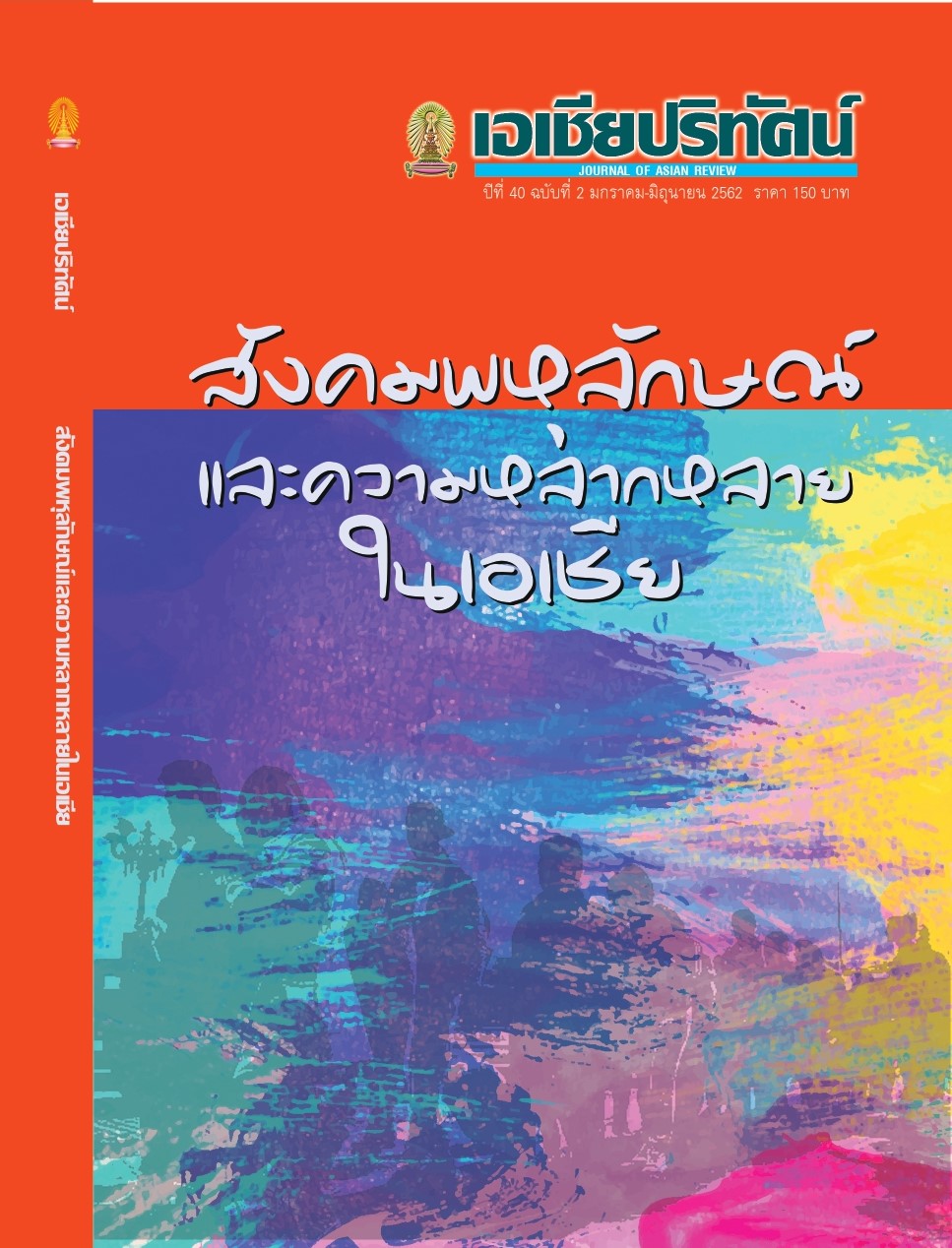"โบซะอิเคียวอิกุ": การให้ความรู้เกี่ยวกับภัยพิบัติในประเทศญี่ปุ่น
Main Article Content
บทคัดย่อ
ในปัจจุบันญี่ปุ่นถือเป็นประเทศหนึ่งที่มีความเข้มแข็งต่อภัยพิบัติในระดับสูง ซึ่งเกิดมาจากการปลูกฝังให้ประชาชนมีความรู้เกี่ยวกับธรรมชาติและสังคม มีทักษะพื้นฐานด้านการเอาตัวรอดและการช่วยเหลือผู้อื่น ตลอดจนมีความต้องการที่จะมีส่วนร่วมในการสร้างสังคมที่ดีและช่วยเหลือผู้อื่น ผ่านกระบวนการการให้ความรู้เกี่ยวกับภัยพิบัติ หรือที่รู้จักกันว่า “โบซะอิเคียวอิกุ” บทความชิ้นนี้เขียนขึ้นเพื่อรวบรวมและเรียบเรียงภาพรวมเกี่ยวกับแนวทางการเสริมสร้างความรู้ความเข้าใจเกี่ยวกับภัยในประเทศญี่ปุ่น “โบซะอิเคียวอิกุ” เป็นเสมือนกุญแจสำคัญประการหนึ่งที่นำมาสู่ความสำเร็จในการรับมือกับภัยพิบัติของประเทศญี่ปุ่น และบทความชิ้นนี้จะเป็นแนวทางให้กับการพัฒนารูปแบบการเสริมสร้างองค์ความรู้เกี่ยวกับภัยพิบัติในเชิงบูรณาการทั้งในและนอกระบบการศึกษา เพื่อเตรียมความพร้อมในการรับมือกับภัยพิบัติที่จะเกิดขึ้นในอนาคต เพื่อนำเสนอภาพรวมของโบซะอิเคียวอิกุ ในประเทศญี่ปุ่นโดยพบว่าโบซะอิเคียวอิกุ เป็นทั้งการศึกษาเพื่อการพัฒนาที่ยั่งยืน และการศึกษาตลอดชีพ เนื่องจากเป็นการเสริมสร้างความรู้ให้เกิดขึ้นทั้งในเด็ก เยาวชน และผู้ใหญ่ ในรูปแบบของการให้การศึกษาแบบองค์รวมอย่างไม่สิ้นสุด ภายใต้แนวความคิด “เด็กรู้ ผู้ใหญ่ทำ” เพื่อก่อให้เกิดคุณภาพชีวิตที่ยั่งยืน อย่างไรก็ดีการจัดทำโบซะอิเคียวอิกุให้ประสบความสำเร็จได้นั้น จำเป็นต้องได้รับความร่วมมือจากผู้ที่มีส่วนเกี่ยวข้องทุกฝ่าย ทั้งนี้ผู้เขียนหวังว่าบทความชิ้นนี้จะเป็นแนวทางให้กับการพัฒนาองค์ความรู้เกี่ยวกับภัยพิบัติในเชิงบูรณาการทั้งในและนอกระบบการศึกษาในประเทศไทย
Bosai Kyouiku, Disaster Risk Reduction, Education, Japan
Article Details
เอกสารอ้างอิง
1. กาญจนา เงารังษี. 2559. “การศึกษากับการพัฒนาที่ยั่งยืน.” Journal of the Association of Researchers 21(2): 13-18.
ภาษาอังกฤษ
2. “Bousai Kyouiku ‘Kiseki’ Yobu/Seizonritsu 99.8% Kamaishi no Shouchuugakusei.” Kahoku Online Network, 2011. Accessed November 26, 2011. http://awata-yokosuka.com/awataHP/awata/bousai/kamaisinokiseki.pdf
2. Building Research Institute (BRI). 2007. “Disaster Education.” Accessed October 30, 2007. http://www.preventionweb.net/files/3442_DisasterEducation.pdf
3. Cabinet Office. 2011. Heisei 23 Nenban Bousai Hakusho. Tokyo: Nikkei Insatsu.
4. Committee for Policy Planning on Disaster Management. 2012. Final Report: Toward the reconstruction for sound and unwavering Japan. Tokyo: Central Disaster Management Council.
5. Fumihiko, Imamura. 2011. Bousai Kyouiku no Tenkai. Tokyo: Toushindou.
6. Jarvis, P. 2006. Towards a comprehensive theory of human learning. London: Routledge.
7. “Kamaishi no Kiseki. Made in New Japan.” 2013. Cabinet Office, Accessed December 25, 2013. http://mnj.gov-online.go.jp/kamaishi_jp.html
8. Katsuya, Yamori. 2006. “Tokushuukiji: Bousai Kyouiku no Frontier.” Jizen Bousai Kagaku. 24(4): 343-344.
9. Kohei, Okamoto. 2007. “Shimin muke Bousai Kyouiku to Chirigaku no Sekinin.” Chiri 52 (8): 52-59.
10. Marsick, V. J. 1987. “New paradigms for learning in the workplace.” In Learning in the workplace, edited by V. J. Marsick, 11–30. London: Croom Helm.
11. Meeting on Disaster Education after East Japan Great Earthquake. 2012. Saishuu Houkoku Heisei 24 Nen 7 Gatsu. Tokyo: Cabinet Office.
12. Ministry of Education, Culture, Sports, Science and Technology. 2013. Gakkou Bousai no tameno Sankou Shiryou: Ikiru Chikara wo Ikumu Bousai Kyouiku no Tenkai. Tokyo.
13. Ministry of Land, Infrastructure, Transport and Tourism. 2013. “Bousai Ishiki Kaikaku to Bousai Kyouiku no Suishin.” Chubu Regional Bureau, Accessed August 8, 2013. http://www.cbr.mlit.go.jp/senryaku/k4_1-2_5_mie.pdf
14. NHK Online. 2013. “Katada Toshitaka Sensei no Inochi wo Mamoru Tokubetsu Jyugyou.” Shinsai Mirai Gakkou. Accessed March 9, 2013. http://www.nhk.or.jp/sonae/mirai/program_sp03/
15. Nobuo, Fukuwa. 2010. Bousai Kyouiku. Bousai. Naikakufu (Bousai Tantou). 1 (55): 4-11.
16. Sharples, M. 2000. “The design of personal mobile technologies for lifelong learning.” Computers and Education (34): 177–193.
17. Seiji, Suwa. 2011. “Yumemiru Bousai Kyouiku: Kodomotachi no Shourai notameni.” In Bousai Kyouiku no Tenkai, edited by Imamura Fumihiko. Tokyo: Toushindou.
18. Tetsuya, Fujioka. 2011. Jizoku Kanouna Shakai wo Tsukuru Bousai Kyouiku. Tokyo: Kyoudou Shuppan.
19. Toshitaka, Katada. 2012. Inochi wo Mamoru Kyouiku: 3.11 Kamaishi karano Kyougun. Tokyo: PHP.
20. Yasuhiro, Suzuki. 2007. “Tokushuu: Bousai Kyouiku ni Naniga Motomerareteirunoka?.” Chiri 52(8): 24-39.
21. Yamori, Suwa, and Funaki. 2007. Yumemiru Bousai Kyouiku. Tokyo: Kouyoushobou.
22. Yoshiyuki, Murayama. 2011. “Chiiki no Tokusei wo Fumaeta Bousai Workshop no Jissen.” In Bousai Kyouiku no Tenkai, edited by Imamura Fumihiko. Tokyo: Toushindou.


